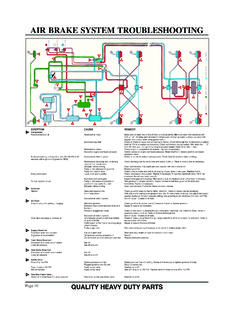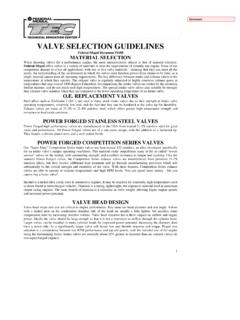Transcription of 30-30 AND OTHER OEM SB SOLID LIFTER CAM …
1 " 30-30 " AND OTHER OEM SB SOLID LIFTER CAM VALVE ADJUSTMENT (Revised 09-23-2008) By John Hinckley and Duke Williams The traditional method of adjusting valves one or more cylinders at a time with each cylinder at TDC is fine for hydraulics and for most SOLID - LIFTER cams, but NOT for the factory " 30-30 " SOLID - LIFTER cam used in '64-'65 L-76 365 HP and L-84 375 HP (FI) Corvette engines (and in '67-'69 Camaro 302/290 Z/28 engines); this cam has VERY long clearance ramps that are .017" high, and at TDC for any cylinder, both the intake and exhaust valve for that cylinder are still on their ramps, NOT on the cam's base circle, which is why the Service Manual for all cars so equipped says specifically to set them "hot and running". There is, however, a better way to adjust the valves with a " 30-30 " - you can set them "cold and not running" by setting the intakes at 90 degrees ATDC and the exhausts at 90 degrees BTDC - so the lifters are on the base circle, not on the clearance ramps.
2 This has been confirmed with cam lift/crank-angle diagrams and analysis of the GM drawing lobe data, and I've done mine this way - results in a nice mechanical "singing" sound, no "clacking", it runs better, sounds better, idle is more stable, and throttle response is improved. Several OTHER Z/28 owners have followed this procedure as well since we developed it, and all of them have seen the same positive results. Set them cold at .023"/.023". The actual measured (stamped rocker arm) ratio at the lash points is actually about :1 (not the design :1, which is a theoretical number), so the clearance ramp, which is exactly .017" high on the lobe, is all taken up at .02329" clearance; .030" clearance with the valve closed is too loose - the ramp ends/begins before the .030"clearance is taken up, resulting in the valve being lifted off and returned to the seat at greater than ramp velocity. This will contribute to valve seat recession, and can cause valve bounce at the seats at high revs - it will also be noisy.
3 You can adjust two valves at each 90-degree rotation point, starting at #1 TDC, turning the crank 90 degrees at a time seven times (measure and mark your balancer first at 90-degree intervals from TDC). Removing the plugs simplifies rotating the crank, but you were going to change them anyway, right? Proceed as follows: TDC #1 - 8E, 2I 90 deg. - 4E, 1I 180 deg. - 3E, 8I 270 deg. - 6E, 4I 0 - 5E, 3I 90 deg. - 7E, 6I 180 deg. - 2E, 5I 270 deg. - 1E, 7I Start at TDC #1, then rotate 90 degrees at a time, setting at .023" cold. If you like, you can then go back after you're done to each cylinder's TDC position and check clearance on that cylinder's two valves, and you'll find that they've closed up to ", indicating that both valves are still on the ramps at TDC, as I pointed out in the beginning. Trivia - the point of max inlet lift on the " 30-30 " cam is at 110 degrees ATDC and 118 degrees BTDC on the exhaust side, so the lobe separation angle is 114 degrees (angle between points of max lift, not the geometric center of the lobe - the lobes on the " 30-30 " cam are asymmetrical).
4 Addendum (May 19, 2003) Lash settings revised 12-14-2005 Optional indexing for Duntov cam revised 09-23-08 (#1, #6 TDC positions will not work for Duntov cam) This procedure should also be used for the LT-1 cam. The exhaust is on the ramp at TDC. The inlet is not, but just barely. With the Duntov cam this indexing procedure may be used, or both valves may be set with the cylinder at TDC of the compression stroke. Adjusting eight specified valves at the #1 and #6 TDC positions as discussed in the 1963 Corvette Shop manual is only valid for hydraulic LIFTER cams. It will not yield accurate settings with any mechanical LIFTER cam because not all the specified valve s lobes at these two positions are on the base circle due to mechanical LIFTER cams long constant velocity clearance ramps. This indexing procedure on page 1 may be used with ANY cam to assure that the lobe is on the base circle, and MUST be used for cams with very long clearance ramps.
5 The following inlet/exhaust valve clearances are recommended with the engine cold and not running. The difference between hot (engine idle speed) and cold clearance on a cast iron pushrod engine is negligible, so clearances can be set cold, which is more convenient. These clearances are computed by multiplying the height of the clearance ramp (which was determined from analysis of the GM drawings that list lobe data to five decimal places every cam degree) by the :1 measured lash point rocker ratio. The computed number is then rounded down. The factory clearances are derived from multiplying the maximum height of the ramp above the base circle by , except the 30-30 cam. The clearances of .025"/.025" listed on the drawing were derived from this formula, but the rationale of the published .030"/.030" is unknown. It is speculated that the higher clearance was specified to solve idle stability problems on FI engines as the larger clearance decreases effective duration slightly, but is definitely tougher on the valvetrain.
6 Idle speed on 30-30 cam FI engines should be set at whatever RPM is required to achieve stability, and this will probably be in the range of 1000-1200 When running hard, such as sustained WOT, the exhaust valve head will heat up considerably. About 80 percent of exhaust valve cooling is through the seat, but the stem temperature will also increase, which will cause the stem to grow and decrease running clearance. This is why exhaust clearance ramps are typically higher than inlet ramps to allow for more stem growth and maintain acceptable running clearance to ensure the valves fully seat. Since the inlet valve is cooled with every fresh intake charge, its temperature and clearance will remain more consistent over the entire engine operating spectrum. The rocker arm nut should be tightened until a light drag is felt on the feeler of the same thickness as the recommended clearance.
7 Then the clearance may be verified by inserting a .001 larger gage, and if it does not go the clearance is between the two gages, which is just right. Note that the inlet clearance specification for the 1963 Corvette was tightened to .008 to give a bit more effective duration. This does not need to be factored anymore. We recommend this tighter clearance for all 327s, and it is optional for 283s for a little more top end power though the effect may not be noticeable. Normal engine service will usually result in slight loosening of the clearance, and Chevrolet service recommendations from the sixties call out a lash check every 12,000 miles as part of a normal tuneup. Duntov cam (283) .010 /.016 (lobe clearance ramp heights: .008"/.012") Duntov cam (327) .008 /.016 (lobe clearance ramp heights: .008"/.012") 30-30 cam .023 /.023 (lobe clearance ramp heights: .017"/.017") LT-1 cam.
8 016 /.023 (lobe clearance ramp heights: .012"/.017") Note: Clearances/clearance ramp heights are listed inlet/exhaust. Interesting facts: The LT-1 cam exhaust lobe is the same as the 30-30 cam lobe (both sides identical), but the point of maximum lift is indexed four degrees earlier at 122 deg. BTDC. The LT-1 inlet lobe is the same at the L-72 cam lobe (both sides identical), but the point of maximum lift is indexed two degrees later at 110 deg. ATDC versus 108 deg. ATDC for the L-72. The LT-1 inlet/L-72 lobe also has greater asymmetry than the 30-30 lobe. The LT-1 cam was, therefore, not "all new", but incorporated two proven lobe designs with indexing refinement to broaden torque bandwidth, and the early phased exhaust event compensates for the small blocks' relatively restrictive exhaust port. The Duntov lobes are symmetrical and identical OTHER than the exhaust lobe having .004" greater clearance ramp height. At any point on the opening and closing flanks (the portion of the lobe above the top of the clearance ramp), as measured from the point of maximum lift, the design exhaust lobe dimension is exactly.
9 00400" greater than the inlet lobe.






